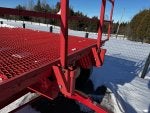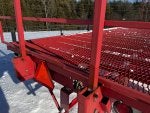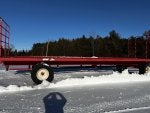We currently run a 1036F (10 bale with a tie row); looking at ways to improve efficiency.
A 15 bale accumulator puts 50% more in each grab and 20% more on a wagon than what we are currently doing.
How likely is a wagon stacked without a tie row going to make it from the field to the barn stacked 6 or 7 high? All of our fields are basically next to the yard so little to no road travel.
I was thinking 9' wide wagons would be better for 36" bales and make the back racks with a decent slope so each layer is offset from the one below. Our current wagons are 8' wide but are starting to get a little tired.
Can a 15 bale grab be picked up from the side creating kind of a tie layer? This would also be helpful for stacking in the barn. Otherwise I can see needing a slanted wall to stack against to make a somewhat safe stack.
A 15 bale accumulator puts 50% more in each grab and 20% more on a wagon than what we are currently doing.
How likely is a wagon stacked without a tie row going to make it from the field to the barn stacked 6 or 7 high? All of our fields are basically next to the yard so little to no road travel.
I was thinking 9' wide wagons would be better for 36" bales and make the back racks with a decent slope so each layer is offset from the one below. Our current wagons are 8' wide but are starting to get a little tired.
Can a 15 bale grab be picked up from the side creating kind of a tie layer? This would also be helpful for stacking in the barn. Otherwise I can see needing a slanted wall to stack against to make a somewhat safe stack.









